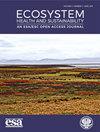中国北方典型农牧交错带区域土地利用格局对生态系统服务的影响
IF 3.4
2区 环境科学与生态学
Q1 ECOLOGY
引用次数: 4
摘要
摘要全面了解生态系统服务的时空演变及其驱动力,对中国北方农牧交错带的生态安全至关重要。然而,具有空间差异的牧区和农业区土地利用模式集聚却很少受到关注。以赤峰不同的LULC(1980-2018)为例,我们将四个关键类别的ES与InVEST进行了比较。利用SEM,我们进一步对比了几个变量分别对畜牧业主导(北部)和农业主导(南部)区域ES变化的影响。结果表明,森林与草原的转换是北方LULC转换的主要方向。相比之下,南方以人类活动为导向的土地往往占据对环境敏感的地方。当忽略土壤保护时,北方的ES变化也优于南方。就区域ES变化的影响而言,自然和LULC政策都表现出积极的影响,而人为因素在北方表现出积极影响,而在南方则表现出消极影响。因此,北方和南方应分别采取生态维持主导和生态恢复主导战略。我们的研究为平衡LULC驱动的生态保护和区域发展之间的冲突提供了适当的区域生态管理建议。本文章由计算机程序翻译,如有差异,请以英文原文为准。
Impacts of regional land-use patterns on ecosystem services in the typical agro-pastoral ecotone of northern China
ABSTRACT A comprehensive understanding of the spatial-temporal evolution and driving forces on ecosystem services (ES) is essential for the agro-pastoral ecotone’s ecological security in northern China. However, the land-use pattern (LULC) agglomeration with spatial differentiation in the pastoral and agricultural areas has been rarely concerned. Taking distinct LULC (1980–2018) in Chifeng as an example, we compared four crucial categories of ESs with InVEST. Using SEM, we further contrasted the effects of several variables on regional ES variations in pastoral-dominated (North) and agriculture-dominated (South) regions, respectively. Results revealed the conversion between forest and grassland oriented the LULC transformation in the North. In contrast, human-activitiy-oriented land tended to occupy environmentally sensitive places in the South. Similar ES variations were supplied with the North outperforming the South when soil conservation was omitted. As for the impacts of regional ES variations, the natural and LULC policies both showed positive effects, whereas the anthropogenic factors showed positive in the North, which was negative in the South. Therefore, the ecologically-maintained-dominant and ecologically-restored-dominant strategies should be separately adopted in the North and South. Our study provided appropriate regional ecological management suggestions for balancing the LULC-driven conflicts between ecological protection and regional development.
求助全文
通过发布文献求助,成功后即可免费获取论文全文。
去求助
来源期刊

Ecosystem Health and Sustainability
Environmental Science-Management, Monitoring, Policy and Law
CiteScore
7.10
自引率
2.00%
发文量
40
审稿时长
22 weeks
期刊介绍:
Ecosystem Health and Sustainability publishes articles on advances in ecology and sustainability science, how global environmental change affects ecosystem health, how changes in human activities affect ecosystem conditions, and system-based approaches for applying ecological science in decision-making to promote sustainable development. Papers focus on applying ecological theory, principles, and concepts to support sustainable development, especially in regions undergoing rapid environmental change. Papers on multi-scale, integrative, and interdisciplinary studies, and on international collaborations between scientists from industrialized and industrializing countries are especially welcome.
Suitable topics for EHS include:
• Global, regional and local studies of international significance
• Impact of global or regional environmental change on natural ecosystems
• Interdisciplinary research involving integration of natural, social, and behavioral sciences
• Science and policy that promote the use of ecological sciences in decision making
• Novel or multidisciplinary approaches for solving complex ecological problems
• Multi-scale and long-term observations of ecosystem evolution
• Development of novel systems approaches or modeling and simulation techniques
• Rapid responses to emerging ecological issues.
 求助内容:
求助内容: 应助结果提醒方式:
应助结果提醒方式:


